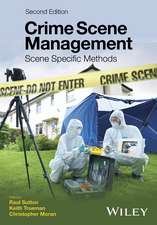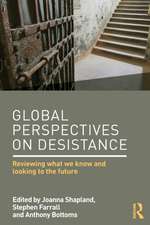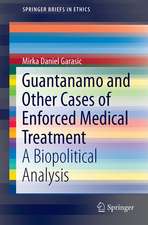Homicide in São Paulo: An Examination of Trends from 1960-2010
Autor Bruno Paes Mansoen Limba Engleză Hardback – 23 mai 2016
This book willbe of interest to researchers in criminology and criminal justice, as well as political science, and international relations, particularly with an interest in South America. The methodology includes both qualitative and quantitative analysis.
| Toate formatele și edițiile | Preț | Express |
|---|---|---|
| Paperback (1) | 383.12 lei 6-8 săpt. | |
| Springer International Publishing – 26 mai 2018 | 383.12 lei 6-8 săpt. | |
| Hardback (1) | 390.25 lei 6-8 săpt. | |
| Springer International Publishing – 23 mai 2016 | 390.25 lei 6-8 săpt. |
Preț: 390.25 lei
Nou
Puncte Express: 585
Preț estimativ în valută:
74.68€ • 79.85$ • 62.26£
74.68€ • 79.85$ • 62.26£
Carte tipărită la comandă
Livrare economică 17 aprilie-01 mai
Preluare comenzi: 021 569.72.76
Specificații
ISBN-13: 9783319131641
ISBN-10: 3319131648
Pagini: 100
Ilustrații: XVI, 189 p. 21 illus. in color.
Dimensiuni: 155 x 235 x 13 mm
Greutate: 0.47 kg
Ediția:1st ed. 2016
Editura: Springer International Publishing
Colecția Springer
Locul publicării:Cham, Switzerland
ISBN-10: 3319131648
Pagini: 100
Ilustrații: XVI, 189 p. 21 illus. in color.
Dimensiuni: 155 x 235 x 13 mm
Greutate: 0.47 kg
Ediția:1st ed. 2016
Editura: Springer International Publishing
Colecția Springer
Locul publicării:Cham, Switzerland
Public țintă
ResearchRecenzii
“Homicide in São Paulo: An Examination of Trends from 1960- 2010 is an excellent supplement to the existing academic resources on the 60-year examination of the rise and fall of the homicide rate in São Paulo. Manso’s work contributes to the existing studies by using interviews of killers to explore the changing social nature of homicide. The book is most likely to appeal to political scientists, criminologists, sociologists and academics in Latin American studies.” (Kimberly M. Pitts, Criminal Law and Criminal Justice Books, clcjbooks.rutgers.edu, May, 2017)
Notă biografică
Bruno Paes Manso, has an Economics degree (University of São Paulo, Brazil) and journalism (PUC-SP). He worked for ten years as a reporter for the newspaper O Estado de S. Paulo. He also served in Veja magazine, Folha da Tarde and Folha de S. Paulo. His is currently a postdoctoral fellow at the Center for the Study of Violence at USP. He completed his master's degree and doctorate in the department of political science at the University of São Paulo, where he researched the rise and fall of homicides in São Paulo. He is the author of the book The X Man - A story about the soul of the killer SP which won the Premio Vladimir Herzog best book report 2006.
Textul de pe ultima copertă
This volume aims to explain the mechanisms for the “epidemic-like” rise in homicide rates São Paolo, Brazil during the late 20th century as well as their sharp decrease after 2000. The homicide rates increased 900 percent from 1960s-2000, and then dropped relatively quickly to 1970s levels over the next decade. While the author finds the Brazilian military government and rise of para-military police forces to be a major factor in the rise of homicide rates in Brazil, research on violent crime trends has demonstrated that it is generally due to the intersection of many factors (for example changes in policing, social or political structures, availability of weapons, economic influences) rather than a single cause. This work integrates individual, neighborhood, and structural dynamics at play in both the rise and drop in homicide rates, and provides a framework for understanding similar phenomena in other regions, particularly in the developing world.
This book willbe of interest to researchers in criminology and criminal justice, as well as political science, and international relations, particularly with an interest in South America. The methodology includes both qualitative and quantitative analysis.
Caracteristici
Examines violent crime trends in São Paulo, Brazil Presents an integrated, contextual explanation for homicide trends Provides a unique view into the historical, cultural, and political landscape of São Paulo from 1960-2010 Includes supplementary material: sn.pub/extras









